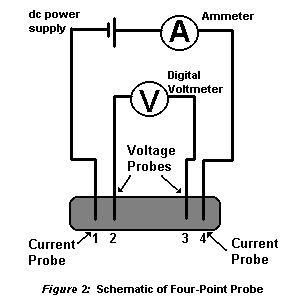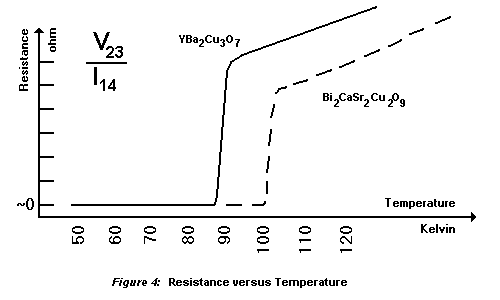The measurement of electrical resistance as a function of the superconductor's temperature yields fundamental insights into its properties. The Critical Temperature, Critical Current Density, and the Critical Magnetic Field, can all be obtained through variations of this basic experiment.
This experiment requires the following pieces of equipment
- A constant current source, or a power supply operating in the current limited mode. The output should not exceed 0.5 Amp. This is connected between the black current probes (probes 1 and 4). An ammeter placed in series with this circuit will measure the current. This current will be referred to as I14. When connecting and disconnecting probes, make sure the power supply is turned all the way down. If the probes are disconnected or connected to an active power supply, they will be damaged.
- A digital voltmeter with a 0.01 milivolt resolution to measure the voltage drop across the yellow voltage probes (probes 2 and 3). This voltage will be referred to as V23.
- A container of liquid nitrogen deep enough to completely immerse the four point probe device.
The voltmeters should be connected as shown in figure 2 . Alternatively, a strip chart recorder with a 10 milivolt full-scale range and a resolution of 10 microvolt may be connected between probes 2 & 3. This will provide a continuous record of the voltage drop. If a two-channel recorder or x-y plotter is used, then the thermocouple reading can also be measured simultaneously. The output from the voltmeters connected to probes 2 & 3, and to the thermocouple, may be sent directly to a computer to store and further analyze the data. The following is a step by step guide for measuring the device Resistance versus its Temperature:

Procedure
- ACTION
Set up the equipment as described above, but do not as yet immerse the device (four point probe) in liquid nitrogen.
RESULT
The voltage across probes 2 & 3 (V23) should measure between 2 and 5 mV. - ACTION
Carefully immerse the device in liquid nitrogen. Use the white, sheathed wire bundle to suspend the device in the liquid. Ensure that the current (I14) remains constant at 0.5 Amp.
RESULT
The nitrogen boils furiously. Wait until the boiling subsides. - ACTION
Record the voltage V23, and across the thermocouple junction.
RESULT
V23 should equal zero. The thermocouple temperature reading should be 77 K. - ACTION
Remove the device from the liquid nitrogen. As it warms, continuously monitor the value of V23. Record the thermocouple reading each time V23 is recorded.
RESULT
Initially, V23 remains constant even as the thermocouple reading increases. Then, V23, the voltage between the probes, abruptly increases, the thermocouple reading corresponding to this jump in voltage is the Critical Temperature, or Tc of the superconductor. The ratio of the voltage between probes 2 & 3 (V23) to current flowing between probes 1 & 4 (I14) is the instantaneous resistance of the superconductor between probes 2 & 3. The probe voltage, and the thermocouple reading could be input directly into a computer or chart recorder for more accurate results. This latter approach also provides a permanent record of the data. This result is shown in figure 4 below.
Precautions
- When pouring liquid nitrogen be careful to prevent any splashing.
- Be careful not to touch the device or wires when they are cold. Follow the safety directions.
- No more than 0.5 Amp of current should pass through the device at any time.
- Use a hair dryer to carefully dry the Four Point Probe device after use. Store it with a desiccant.
- The probe and thermocouple wires are very brittle when cold. Please handle them with care.
Some Questions
- What effect would one expect if the Critical Temperature is measured with the device placed inside a functioning electromagnet?
- Why is the transition in resistance gradual at the Critical Temperature?
- A simple two-probe measurement of device resistance below its Critical Temperature exhibits a non-zero value. Why?
Determination of the Critical Temperature
The Critical Temperature (Tc) is obtained during the measurement of the electrical resistance as function of the Temperature of the superconductor above. The Critical Temperature of the Bi2Sr2Ca2Cu3O10 superconductor is about 108 Kelvin versus about 95 Kelvin for the YBa2Cu3O7 material. These results are shown below in figure 4.

Information Courtesy of CSI Superconductors

